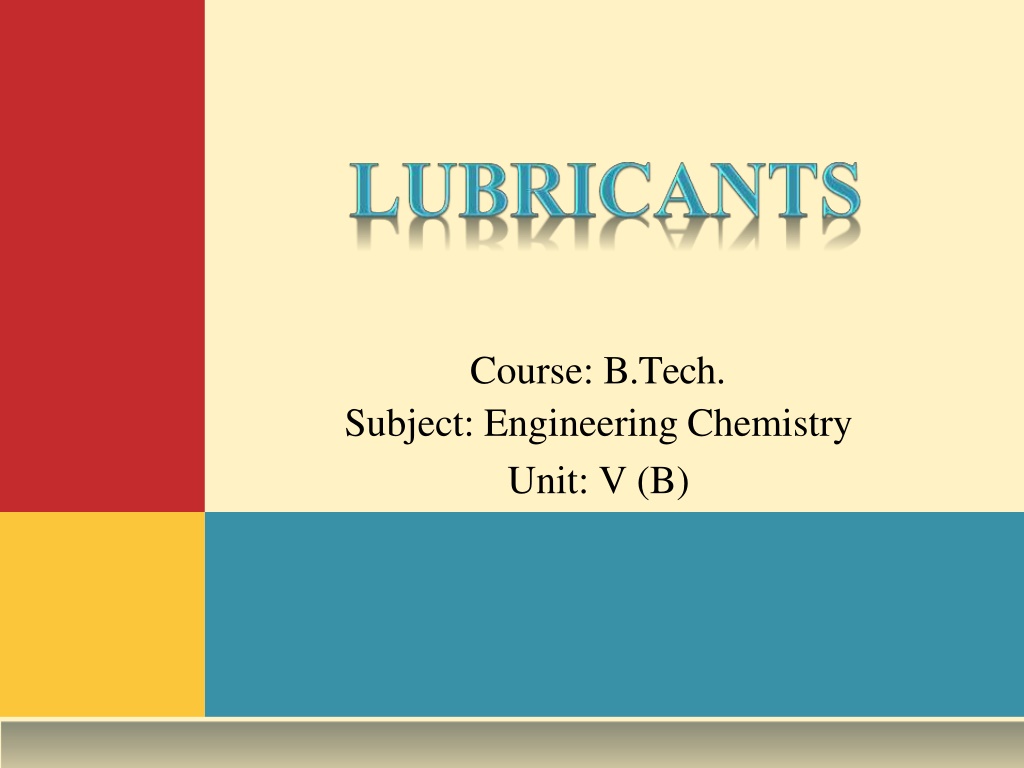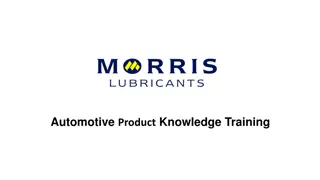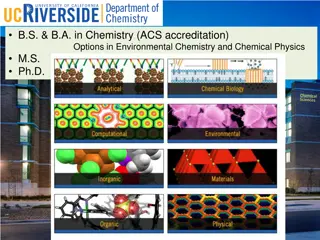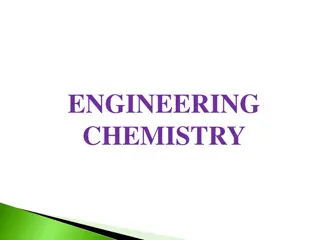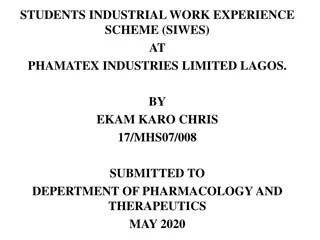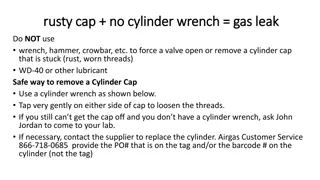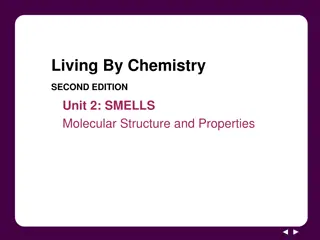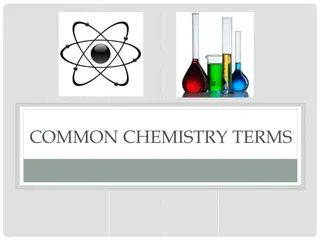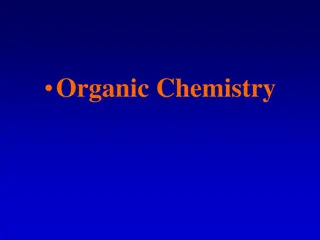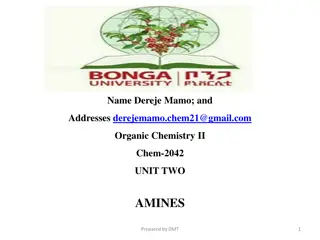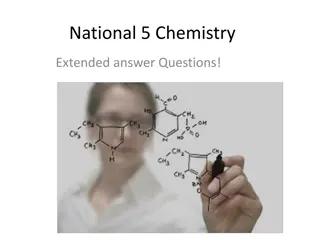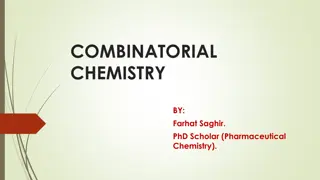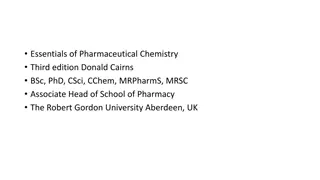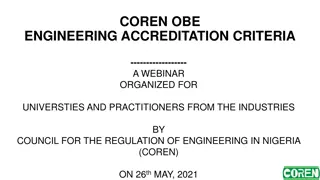Understanding Lubricants in Engineering Chemistry
Lubricants are substances introduced between moving surfaces to reduce friction, heat generation, and wear and tear of machine parts. They act as thermal barriers, coolants, seals, and corrosion inhibitors. Good lubricating oils have high boiling points, adequate viscosity, and non-corrosive properties. Various types of lubrication include thick film, thin film, and extreme pressure lubrication. Additives such as antioxidants and antiwear agents enhance the performance of lubricants.
Download Presentation

Please find below an Image/Link to download the presentation.
The content on the website is provided AS IS for your information and personal use only. It may not be sold, licensed, or shared on other websites without obtaining consent from the author. Download presentation by click this link. If you encounter any issues during the download, it is possible that the publisher has removed the file from their server.
E N D
Presentation Transcript
Course: B.Tech. Subject: Engineering Chemistry Unit: V (B)
DEFINITION: LUBRICANTS A lubricant is substance (often liquid) introduced between two moving surfaces to reduce the friction between them. Fluid which is introduced in between moving parts in order to reduce the friction, generated heat & wear and tear of machine parts are called Lubricants. This process of introducing lubricant is called Lubrication.
Gear and Transmission oils Automotive Oils Automotive Grease
COMPOSITION Typically oil(petroleum-mineral oils) and less than 10% additives contains 90% base Non liquid lubricants contains Grease, graphite, Teflon disulphite), plumbing etc. powder(dry Molybdenum tape used in Those non liquid lubricants provide lubrication at higher temp.(up to 350 C)
ADDITIVES USED IN LUBRICANTS (1)Anti oxidant ---Aromatic amines,Phenols,Sulphides and phosphates (2)Corrosion Inhibitor ---Amino salts andsalts of sulphonic acids (3)Antiwear agents --- Tricresyl phosphate (4) Foam inhibitors --- Glycerols
Functions of Lubricants It acts as a thermal barrier and reduces friction and wear and prevents welded joints Avoids seizure of moving surfaces Acts as coolant Acts as a seal and prevents entry of dust, moisture, & dirt between moving parts Some lubricants acts as corrosion inhibitors thus reduce operational cost .
A good lubricating oilshould have: High boiling point AdequateViscosity Low freezing point High oxidation resist Non Corrosive properties Good thermal stability 2
Types Of Lubrications Thick Film or Fluid Film or hydrodynamic Lubrication Thin Film or Boundary Lubrication Extreme Pressure Lubrication
This is also called Hydrodynamic or fluid film lubrication. Two sliding metal surfaces are separated from each other by a thick film of fluid ( 1000A thick). The coefficient of friction in such cases is as low as 0.001 to 0.03 Lubricants used : Hydrocarbon Oils. Provided in delicate instruments such as watches, clocks, light machines like sewing machines, scientific instruments etc. o
This lubrication is alsocalled Boundary Lubrication. Its used for high load conditions. Very thin film of the lubricant is adsorbed on the surface by physical or chemical forces or both. The coefficient of friction is 0.05to 0.15 Lubricants used forboundary lubrication should have highviscosity index, resistance to heat and oxidation, good oiliness. Examples are Organic oils, Vegetable oils, Graphite and MoS2, Mineral Oils etc.
This lubrication is for very high press/temp/speed sliding surfaces. Extreme pressure additives are used along with the lubricants. Chemicals used are compounds of Cl, S & P. These additives form solid surface films of Cl, S & P. High melting point metal compounds are good lubricants. E.g. graphite is used for drawing wires made up of mild steel. 3
Classification of Lubricants Liquid Lubricants Semi Solid Lubricants Synthetic Lubricants Solid Lubricants Eg.Mineral Oil, Petroleum Oil, Vegetable Oil etc Eg. Graphite, Molybdenum Disulphide etc. Eg. Petroleum jellies
TYPES OF LUBRICANTS Solid lubricants e.g Wax, Talc, Mica, Molibdenum disulphide Semi solid lubricants e.g. Grease and Vaseline Liquid Lubricants e.g. Mineral oils, Vegetable oils, Animal oils Synthetic lubricants e.g. Polyglycols, Silicones, Organic amines, Imines,Amides.
FEATURES OF LUBRICANTS Increase efficiency and reduce wear Dissolving or transporting foreign particles and distributing heat Single largest application is in form of Motor Oil, protecting internal combustion engines in motor vehicles and powered equipments Another approach is to use ball bearings, roller bearing or air bearings which in turn require internal lubrication themselves
Its a measure of a fluids resistance to flow. Viscosity of the lubricating oil determines its performance under operating conditions. A low viscosity oil is thin and flows easily. A high viscosity oil is thick and flowsslowly. As oil heats up it becomes more viscous (Becomes thin) Too low viscosity of the liquid > Lubricant film cannot be maintained between the moving surfaces > Excessive wear. Too high viscosity of the liquid > Excessive friction. Selected Lubricant must be proper viscous. Viscosity is usually expressed in centipoise or centistoke.
Iodine number is the number of Gms equivalent of iodine to amount of ICl absorbed by 100gm of oil. Each oil has its specific Iodine Number. So Iodine Number determines the extent of contamination of oil. Low Iodine Number is desirable in oils. Some oils and their Iodine Numbers are given below : Iodine Number >150 Oil Dryingoil Example Linseed oil, tungoil 100-150 <100 Semidryingoil Non-Dryingoil Castor oil , Soyabeanoil Coconut oil, Oliveoil
Aniline point is the Min temp at which oil is miscible with equal amt of aniline Aniline Point is a measure of aromatic content of the lubricatingoil. Low Aniline Point oil have high aromatic content which attacks rubber seals. Higher Aniline point means low %age of hydrocarbons(desirable). Thus Aniline Point is used as an indication of possible deterioration of rubber sealing etc. Determination of Aniline Point: Aniline+ sample oil (equal) Homogeneous solution Heated in Testtube Cooled Cloudiness The temperature at which separation of the two phases (Aniline + oil) takes place is the AnilinePoint.
Emulsification is the property of water to get mixed with water easily. Emulsions can be oil in water emulsion or water in oil emulsion. A good lubricating oil should form such an emulsion withwater which breaks easily. This property is called demulsification. The time in seconds in which a given volume of oil and water separates out in distinct layers is called steam demulsification number. A good lubricating oil should have lower demulsification number. Quicker the oil separates out from the emulsion formed, better is the lubricating oil. In cutting oils the higher the emulsification number, better the oil is. This is because the emulsion acts as a coolant as well as a lubricant.
Flash Point is the min temp at which the lubricant vaporizes that ignite fora moment when tiny flame is broughtnear. Fire Point is the Min temp at which the lubricant s vapours burn constantlyfor 5 seconds when tiny flame is broughtnear. If flash point < 140 F = Flammableliquids And if flash point > 140 F =Combustibleliquids. The flash and fire points are generally determined byusing Pensky-Marten s apparatus. Oil under examination is filled in the oil cup up to the mark and heated by the air bath by a burner. Stirrer is worked b/n tests at a rate of about 1 2 rev/sec. Heat is applied so as to raise the oil temp by about 5c/min. The temp at which distinct flash appeared in side the oilcup is recorded as flashpoint. The heating is continued to record the fire point. 4
Drop Point is the Temperatureat which grease passes from thesemi- solid to the liquid state. So, it determines the upper temp limit for the applicability of grease. Determination : Beaker isheated. Temperature is raised. Grease sample passes from asemi- solid to a fluidstate. Temp at which its first drop falls from the opening is recordedas drop-point. 5
Cloud Point is the temp at which the lubricant becomes cloudy or hazy when cooled. Pour Point is the temp at which the lubricant just ceases to flow when cooled. Both indicates suitability of lubricant in cold conditions and thus must be low.
Its the mgs of KOH required to saponify 1 gm of oil. Saponification is hydrolysis of an Easter with KOH to give alcohol and Na/K salt of acid.
USES Other uses are for cooking, biomedical applications on human(lubricants for artificial joints).
APPLICATIONS Automotive Industry-Engine oil,Automatic transmission fluid, Gearbox fluid, Break fluids. Tractor(One lubricant for all systems) Other motors(2 stroke engine oil) Industrial(Hydraulic oils, Air compressor oils, Gas Compressor oils, Gear oils Bearing and circulating system oils, Refrigerator compressor oils) Aviation Marine
REFERENCES www.motosport.com 1. www.umongo.co.za 2. http://www.vidyarthiplus.in/2012/01/engineering- chemistry1-lubricants.html# 3. www.aimil.com 4. www.machinerylubrication.com 5. Atextbook of Engineering Chemistry by Shashi chawla 6.
